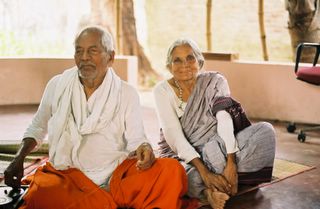Lessons in Stone
February 12, 2006
Sekar had called me around 11 the night before and asked if I would like to go for a walk in the morning at 6:30. That can only mean the Brihadesvara Temple, one of UNESCO’s World Heritage sites. It should be good, early in the morning before there are any other people there. The sun is just coming up as we walk towards the temple, surrounded by massive battlements built by the Cholas, the great empire responsible for conquering much of South India and Southeast Asia, conveying its culture far and wide.
What, though, we might ask, remains from these military and political adventures? The answer gives us pause as we think of recent history. What is remembered about the Cholas is their art, their glorious bronzes, their stone temples, their images of the divine. And another perhaps darker legacy, the social ordering of Tamil society. We wonder how and to what extent the caste system, and what it has done to oppress so many people even as it wove a social system that has remained more or less stable for a thousand years, came from the Cholas. But then again, this social ordering may go even further back. What is this social organization that allows a few to trample on the dignity and humanity of so many?
We are reminded here, too, of the hybridity of South Asia, of how multiple cultures come together and work out arrangements, exchanging and interchanging, creating hybrid cultures. We are even seeing this today in the society around LAFTI. Many, if not most, of the Brahmins seem to have left Thanjavur. I do not see the agraharams that used to appear with their red and white striped walls when I was passing through villages along the banks of the Cauvery. There are other land-lords now who use the labor of the Dalits: middle and other upper caste people, Muslims enriched by money from the Gulf, Malaysia, and elsewhere. But always the labor, the hard back-breaking work of actually maintaining the fields, goes to those at the bottom of the society and especially the Dalits.
We marvel at the power and the presence of the Cholas, even as we reflect on larger lessons from the society. Dr. V., I might add, has told me his belief that the bronzes of the Cholas and much of their art, shows a distinct Southeast Asian influence, that the stapathi bronze artisans of the village of Swamimalai are likely descended from generations of Southeast Asians. Again, hybridity, despite the privileging of purity and the depredations associated with concepts of pollution. What can this mean for a society in transition?
We return to the hotel and have a delicious breakfast of dosai and iddly and rich coffee. Then we are off, Sekar and his group to the pilgrimage sites of Velankani (Christian) and Nagore (Muslim). They drop me off on the way after Tiruvarur as we recognize the sign-board for LAFTI.


1 Comments:
Dr. V., I might add, has told me his belief that the bronzes of the Cholas and much of their art, shows a distinct Southeast Asian influence,
Who is Dr. V? Has this theory been written about anywhere?
Post a Comment
<< Home